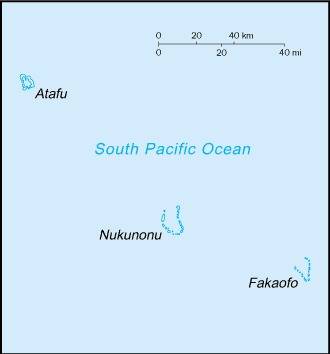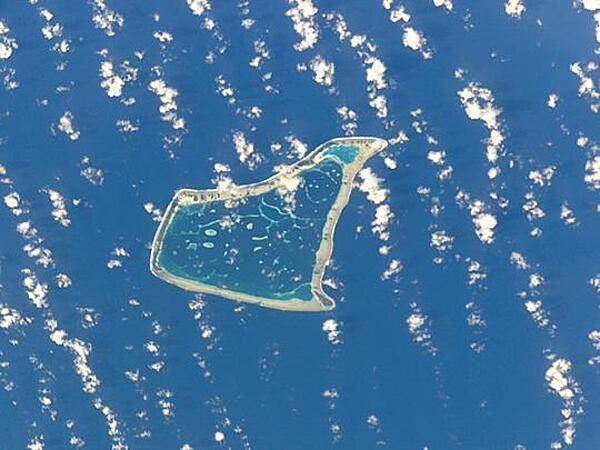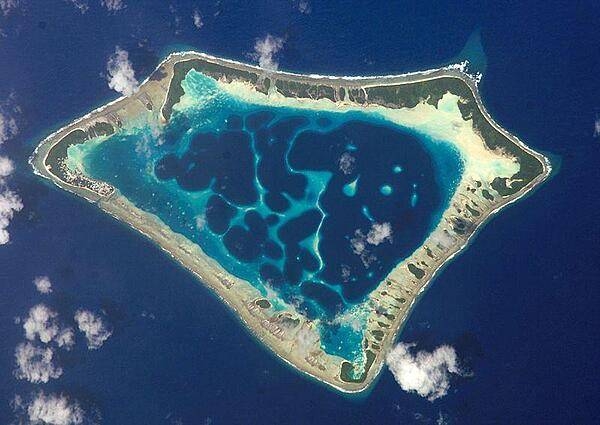46 Tokelau (NZ)

A yellow stylized Tokelauan canoe on a dark blue field sails toward the manu – the Southern Cross constellation of four, white, five-pointed stars at the hoist side. The Southern Cross represents the role of Christianity in Tokelauan culture and, in conjunction with the canoe, symbolizes the country navigating into the future. The color yellow indicates happiness and peace, and the blue field represents the ocean on which the community relies.
Flag courtesy of the CIA World Factbook

Map courtesy of the CIA World Factbook

Nukunonu is the largest of the three islands that comprise Tokelau. It is composed of a roughly tear-drop shaped atoll that includes 5.5 sq km of land and whose central lagoon encompasses an area of about 90 sq km.
Photo courtesy of the CIA World Factbook

Fakaofo is one of the three islands that make up Tokelau. Its land area is only 3 sq km; the lagoon covers an area of about 45 sq km.
Photo courtesy of the CIA World Factbook

At roughly 8 km (5 mi) wide, Atafu Atoll is the smallest of three atolls comprising Tokelau. Land area is only about 2.5 sq km and the lagoon’s area is about 15 sq km. The primary settlement on Atafu is a village located at the northwestern corner of the atoll – indicated by an area of light gray dots in the left part of this photograph. The typical ring shape of the atoll is the result of coral reefs building up around a former volcanic island. Over geologic time, the central volcano subsided beneath the water surface, leaving the fringing reefs and a central lagoon that contains submerged coral reefs.
Photo courtesy of the CIA World Factbook
Last updated on October 18, 2025
Government
According to Britannica, Tokelau is administered as part of New Zealand under the Tokelau Islands Act of 1948, which has been amended several times; Tokelauans have New Zealand citizenship. An administrator is appointed to a three-year term by New Zealand’s minister of foreign affairs and trade, but most authority is delegated to the Tokelau Council for Ongoing Government (or Tokelau Council), comprising elected leaders from each of the atolls, from which the head of government (Ulu-o-Tokelau) is selected annually. The meeting place of the Tokelau Council is rotated yearly among the three atolls. Legislative power rests with the General Fono (assembly), whose members are elected every three years by universal adult suffrage and represent the entire territory. The General Fono holds several annual sessions that can take place on any one of the atolls. It handles budgets, exercises a limited rule-making power, and makes recommendations to the New Zealand Parliament. The Tokelau Council takes over these duties when the General Fono is not in session.
Local government on each atoll is in the hands of the Taupulega (Council of Elders), whose members are the heads of family groups along with two elected members known as the faipule (village leader) and the pulenuku (village mayor). The three faipule and the three pulenuku form the Tokelau Council.
Civil / National Aviation Authority (CAA/NAA)
Airspace
SkyVector – Google Maps – ADS-B Exchange
ICAO countries publish an Aeronautical Information Publication (AIP). This document is divided into three parts: General (GEN), En Route (ENR) and Aerodromes (AD). ENR 1.4 details the types of airspace classes they chose to adopt from classes A through G.
Drone Regulations
Tokelau has no independent aviation authority and relies entirely on the CAA for drone regulation, following New Zealand Civil Aviation Rules Parts 101 and 102 for all UAS operations.
Advanced Air Mobility (AAM) Regulations & Policies
None found by the author.
However, should you, the reader, happen to stumble across something to the contrary, please email the author at FISHE5CA@erau.edu and you may be mentioned in the ACKNOWLEDGEMENTS section of this book by way of thanks for contributing to this free eBook!
Advanced Air Mobility (AAM) News
None found by the author.
However, should you, the reader, happen to stumble across something to the contrary, please email the author at FISHE5CA@erau.edu and you may be mentioned in the ACKNOWLEDGEMENTS section of this book by way of thanks for contributing to this free eBook!
Short Essay Questions
Scenario-Based Question
You have been hired by a Drone Startup Company. Your boss has immediately assigned this job to you.
They need you to prepare a one-page memo detailing the legalities of using a drone in Tokelau.
They need you to mention any national laws and local ordinances.
They specifically want to know what airspace (insert pictures) you will be operating in and whether or not you need an airspace authorization.
Does it matter whether or not you are a citizen of the country?
Lastly, there is a bonus for you if, as you scroll through this chapter, you find any typos or broken links!
Short Essay Questions
- What are the drone categories?
- How is registration addressed?
- How is remote ID addressed?
- What are the model aircraft rules?
- What are the commercial drone rules?
- Are there waivers or exemptions to the rules? If so, for what?
- Would you share a link to an interactive airspace map?
- How is BVLOS addressed?
- How can you fly drones at night?
- How can you fly drones over people?
- Where do you find drone NOTAMs?
- What are the rules for drone maintenance?
- What are the rules for an SMS program?
- What are some unique rules not mentioned above?
- What are the C-UAS rules?
- What are the AAM rules?

